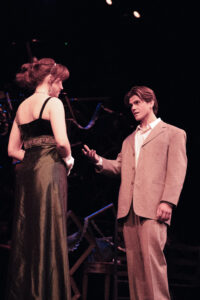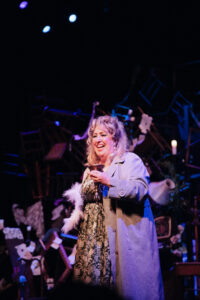From the Nashville Shakespeare Festival
Pride and Prejudice and Plays
Pride and Prejudice is a beloved classic that has resurfaced as younger audiences have discovered the magic of Jane Austen through the 2005 film adaption directed by Joe Wright, which stars Kiera Knightly as Elizabeth Bennet and Matthew Macfadyen as Mr. Darcy. This movie is, of course, a gateway to the 1995 BBC television series, comprised of six bingeable episodes and all things costume drama. This inevitably leads to finally reading the book and realizing that the stuffy book your mother tried to force you to read as a child was, in fact, rather good.

At first glance, Pride and Prejudice has all the fixings of a classic enemies-to-lovers trope. The cast of characters includes Mr. and Mrs. Bennet, their five single daughters, and their various friends and relations. Without giving too much away, the second eldest Bennet daughter, Elizabeth, or Lizzy, is an example of a classic headstrong heroine who laughs at anyone who thinks too much of themselves and doesn’t want to get married. Mr. Darcy is the tall, dark, and aloof love interest who allegedly thinks too much of himself and not enough of Lizzy. Jane is the eldest sister; a loving girl who rarely truly speaks her mind. Mary is the quintessential middle child, neglected on all sides by siblings and parents, and the youngest, Lydia, is a prodigious flirt.
Pride and Prejudice is a captivating introduction to the Regency period in England during which class, inheritance, and dances played a large role in people’s lives. However, when you look closely, Pride and Prejudice critiques England’s treatment of women in Jane Austen’s day. A woman could only provide for herself through marriage or the provision of other male relatives. Lizzy, our main character, has no interest in marrying, unlike her sisters, and through her unconventional actions causes quite a stir. If the movie, series, and book aren’t enough to quench your appetite for Pride and Prejudice, or if you are looking for an introduction to one of Jane Austen’s most successful works, Belmont has teamed up with the Nashville Shakespeare Festival to bring you Pride and Prejudice, the play!
Adapted by Kate Hamill, this version of Pride and Prejudice has something for everyone. It takes the beloved characters from the original and highlights their traits in unexpected and often hilarious ways. Mr. Bingley, Mr. Darcy’s closest friend, has always been a humble, lovable character if a little shallow. In this adaptation, these traits are taken to new heights, turning the well-meaning Mr. Bingley into a goofball who quite literally plays fetch with Miss Jane Bennet. This adaption’s dialogue is fast and furious, with cuttingly intelligent quips thrown between cast members. In addition to breakneck humor, there are also intense, poignant moments throughout the play, that the cast manages to balance well.

The cast consists of eight people who, excluding Lizzy and Mr. Darcy, double, multiple, often gender-bent, roles. Cast member JW Burkhart pulled shrieks of laughter from the audience with the delightful mannerisms of the verbose Mr. Collins. Burkhart also portrays the deceitful Mr. Wickham and the stuck-up Miss Caroline Bingley. Mr. Bennet and Charlotte Lucas, are both played by Sean Martin who embodies both characters. As Mr. Bennet, he completely submerges himself in the often-distant and disinterested father who repents creating sweet scenes of paternal reconciliation, only to change with the donning of a bonnet into Lizzy’s friend the ever-practical Charlotte Lucas. Mr. Bennet’s other half, Mrs. Bennet, is played by Brenda Sparks who knocks her role out of the park! Her chronic bouts of nerves, brought on by trying to find husbands for all four of her daughters, make Mrs. Bennet hysteric and leave the audience laughing hysterically.
The set in Troutt Theatre, designed by Em Mills, was intricately decorated with flickering candles. A mass of chairs and other furniture were hung haphazardly from floor to ceiling throughout the set. Little doilies, bits of white lace, and other fabrics were strewn around the stage in combination with paintings, books, and various garlands making the set simultaneously cozy and eye-catching. A gauzy screen served as the backdrop of the set, which was utilized in tandem with various creative lighting changes to show the silhouettes of cast members, behind the scenes. Overall, the set changes were minimalistic, but the actors were so convincing that each scene took on a completely unique life of its own. They made it easy for the audience to envision the characters in their living room at home and, at the next moment, in a grand ballroom waltzing with red-coat soldiers.
All of the cast did a phenomenal job, and I cannot say enough about the witty and sometimes utterly absurd humor used throughout the play. There are still five performances left at the Troutt Theatre from February 27th to March 2nd where you can try out Austen for the first time or experience her classic tale in a whole new way.



